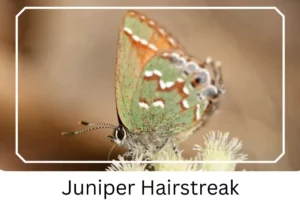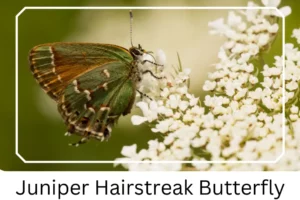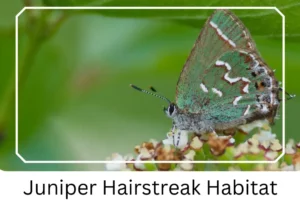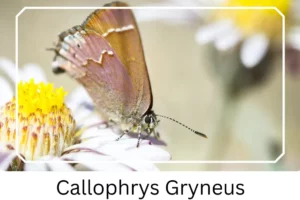Juniper Hairstreak (Callophrys gryneus)
The Juniper Hairstreak is a captivating butterfly species native to North America, renowned for its striking color variations and unique habitats. This butterfly is distinguished not only by its beauty but also by its ecological significance and the intriguing variations found across its subspecies. Its presence in meadows, fields, and clearings during the warmer months adds a vibrant layer to the natural tapestry of these environments.
Scientific Classification
- Family: Lycaenidae
- Genus: Callophrys
- Common names: Olive hairstreak
- Scientific Name: Callophrys gryneus
Overview
Belonging to a complex group, the Juniper Hairstreak is subject to ongoing scientific study due to its varied subspecies or races, some of which might represent distinct species. These butterflies are a wonder of adaptation, displaying a range of colors and patterns that blend seamlessly into their natural surroundings. Their lifecycle from caterpillar to adult showcases remarkable transformations, reflecting the intricate balance of ecosystems they inhabit.
Description and Identification
Caterpillar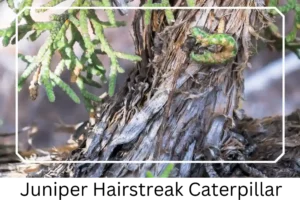
The caterpillar stage of the Juniper Hairstreak is a sight to behold, with a dappled green body accented by a pale, vertical stripe down its back and adorned with dull yellow spots. A distinctive pale yellow line runs along its side, adding to its camouflage among the foliage.
Pupa
Transitioning into the pupa stage, the chrysalis varies in color from light brown with black mottles in eastern populations to a darker brown in the west, indicating the species’ adaptability to different environments.
Adult Butterfly
Sexual Dimorphism: This varies significantly between subspecies, reflecting the butterfly’s adaptability and evolutionary diversification.
Color and Appearance: The adult Juniper Hairstreak’s wings are a marvel, with males and females displaying differences in hue and pattern. The western population has males with a red-brown to tawny coloration, while females exhibit a blackish brown shade. The eastern counterparts boast an olive green sheen in males and a deeper brown in females. The underside of their wings features a mix of rust-red and green, with distinctive white lines and marks that aid in identification.
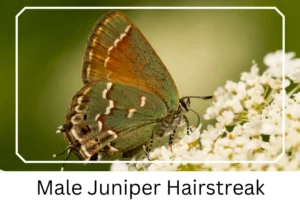
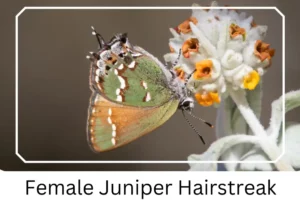 Average Wingspan: Ranges from 1 to 1¼ inches (2.6 – 3.2 cm), a testament to the butterfly’s delicate yet resilient nature.
Average Wingspan: Ranges from 1 to 1¼ inches (2.6 – 3.2 cm), a testament to the butterfly’s delicate yet resilient nature.
Flight Pattern: Known for their fast and erratic flight, these butterflies can be challenging to track as they move from flower to flower.
Eggs
The eggs are spherical, pale green, and adorned with white ridges, laid singly on host plant leaves, ensuring the next generation’s survival.
Quick Facts | |
| Distribution | Ranges from Texas in the east to Montana, North Dakota, Nebraska, and extends south to California, Arizona, New Mexico, and Baja California. |
| Habitat | Prefers old fields, bluffs, barrens, juniper, pinyon-juniper woodlands, and cedar breaks. |
| Species or Race | Includes Olive juniper hairstreak (C. g.gryneus), Sweadner’s juniper hairstreak (C. g. sweadneri), and several others, highlighting the species’ diversity. |
| Lifespan of Adults | Remains under study, reflecting the need for further research. |
| Host Plants | Utilizes redcedar, California juniper (J.californica), and Utah juniper (J.osteosperma) among others. |
| Adult Diet | Primarily nectar from a variety of flowers, showcasing their role in pollination. |
How to Identify Juniper Hairstreak?
Identifying a Juniper Hairstreak can be an enchanting experience, marked by the observation of its unique color patterns and behaviors. Look for the butterfly’s distinctive green coloring on the underside of its wings, which sets it apart from other species. The presence of white lines and spots, especially on the underside of the wings, is a key identifier. Observing the butterfly in its preferred habitats, such as old fields, bluffs, and juniper woodlands, can also provide clues to its identity. Paying attention to its flight pattern, which is notably fast and erratic, can help observers distinguish the Juniper Hairstreak from other butterflies. By combining these visual cues with knowledge of their host plants and distribution, one can confidently identify these remarkable butterflies.
Did You Know?
- Previously thought to be separate species, the eastern and western populations of the Juniper Hairstreak have been found to hybridize, offering fascinating insights into butterfly evolution.
- The Juniper Hairstreak’s varying subspecies and their adaptability to different habitats underscore the importance of conservation efforts to protect their diverse ecological niches.
Conclusion
The Juniper Hairstreak butterfly is a testament to nature’s beauty and complexity. With its diverse subspecies and varied habitats, it plays a crucial role in the ecosystems of North America. By learning to identify and appreciate this butterfly, we can foster a deeper connection to the natural world and recognize the importance of preserving its diversity for future generations.
Juniper Hairstreak Pictures

Scientific Classification

- Family: Lycaenidae
- Genus: Callophrys
- Common names: Olive hairstreak
- Scientific Name: Callophrys gryneus

